
All categories
Featured selections
Trade Assurance
Buyer Central
Help Center
Get the app
Become a supplier

(11350 products available)
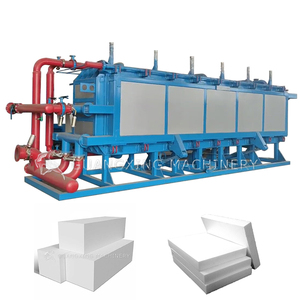


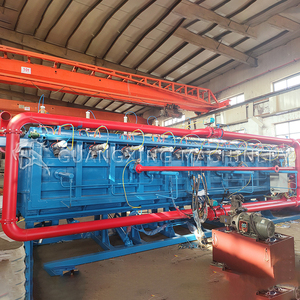




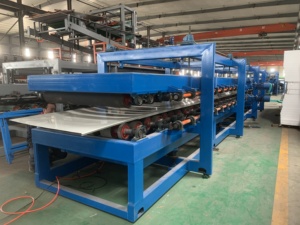
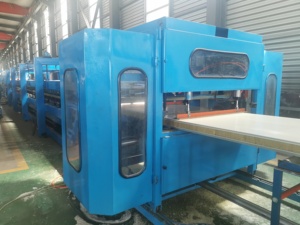
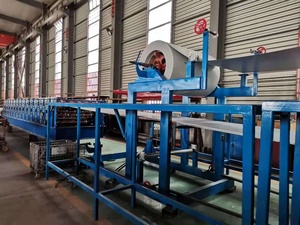
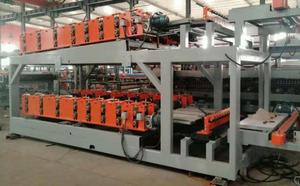

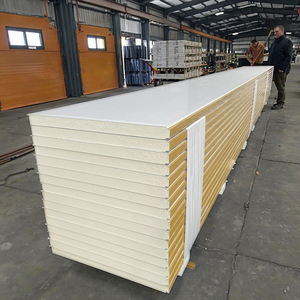


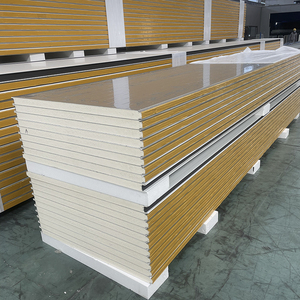


















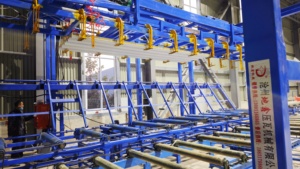

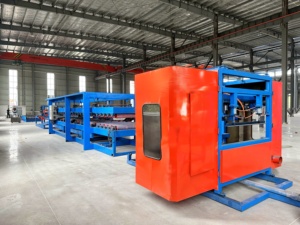








The sandwich panel production line is used to manufacture composite panels comprising two thin skins and an insulating core. Such panels are used for building cold storage, clean rooms, refrigeration, and other industrial facilities. There are several ways to make these panels, some of which are automated for high-capacity factories.
Continuous production line
A continuous sandwich panel production line makes panels at a constant speed, with the help of a movable conveyor. The panels usually have a PU core insulation. The core material is mixed with a foaming agent on the lower side of a movable conveyor. A release paper is placed above the foam, and the upper skin of the panel is placed over it. The lower part is called the foam formation area, where the foam expands and forms the insulating layer. In some cases, the core can be honeycomb or rock wool. After this area, the panel goes through a part of the conveyor where the foam is cured. The panel is then cut to size.
Benefits: The continuous production line can be fully automated. It can produce up to 10,000 square meters in one shift. The panels have a consistent quality, with no defects on the surface. Because foam is formed in situ, waste material is less than in other production lines.
Intermittent production line
The intermittent production line can be manual, semi-automatic, or fully automatic. In this case, the skins and the core material are laminated under heat and pressure in a hot press machine. After pressing, the panel is cut to size. The core material can include polyurethane, polystyrene, or rock wool.
Benefits: This kind of machine is more affordable for smaller businesses and can make up to 5,000 square meters in one shift.
Roll forming machine
The roll forming machine makes the steel sheet, which is the outer skin of the panel. The machine rolls the skin into an insulated panel with a core of polyurethane, polyamide, or other materials. The panel is also cut to size.
Benefits: This machine is better value for money than other machines for making curved sandwich panels like domes at lower costs.
While the continuous and intermittent production methods are better for making large numbers of panels, roll forming machines can be more affordable for smaller firms that need to make customized panels. The kind of production line needed will also depend on whether the outer skin of the panel is made from cement, glass, steel, or aluminum. Therefore, a sandwich panel production line is available for varied uses in different industries.
The sandwich panel production line has many specifications based on different needs. For example, the desired thickness range of the panels can determine the specification. The production line can create panels with a thickness range of, say 50 to 250 millimeters. Also, the width and length of the panel can dictate the width and length of the production line. Usually, the line will create panels that are 1,200 to 2,500 millimeters wide and 5,000 to 15,000 millimeters long.
Another specification is the core material's density, which can range from lower to higher density. The principal type is polyisocyanurate, polyethylene, polyurethane, glass wool, rock wool, extruded polystyrene, or expanded polystyrene. One important feature is the steel coating and thickness for the outer layer of the sandwich. Usually it is 0.4-1.0mm PPGI or GI.
The whole production line can have many different machines, including cutting machines, draping machines, automatic profiling machines, and more. Their power requirements will vary according to the machine. Some may need a three-phase 380/400/415V power supply, but others will require a generator set with an N-1,1 typical diesel engine, or being fully loaded with a power of over 200 Kw.
Another important specification is whether the production line is manual, semi-automatic, or fully automatic. Fully automatic lines may have a computerized touch screen that is easy to use and has multiple languages.
Lastly, the production capacity is an essential specification. Depending on the combination of machines, speeds of 3 to 50 meters per minute are available. Generally, the higher the speed, the longer the machine length.
It is essential to maintain the sandwich panel production line, so it always works and has a more extended life. Manufacturers need to inspect the machine components regularly and see if they need to be tightened or replaced. They should clean them and remove any debris or impurities.
Also, one should ensure there is enough lubricating oil in the parts that need to be lubricated to reduce wear and tear. Using them should be the same as always to avoid damaging the equipment parts. Regularly clean the filters of any vacuum, dust, or waste storage devices so that the sandwich panel production line operates efficiently. Using high-quality lubricants for the equipment can ensure longer use and better durability.
The sandwich panel production line is creating insulated panels for numerous industries. This is creating energy-efficient and cost-effective solutions for construction and refrigeration industries. One primary application of the machine is to make insulation panels for the construction industry to make energy-saving buildings. The machine creates panels with materials such as PU, EPS, and phenolic foam, which provide thermal insulation for commercial buildings, warehouses, factories, cold storage places, and heating and cooling systems.
Also, insulation panels created by a sandwich panel production line are being used as components of portable houses. The lightweight, high-strength, and thermal insulation features of the sandwich panel make it a popular choice for transporting and assembling portable houses. These houses are used as temporary residences, field work offices, construction site dormitories, and convenient housing solutions in rural areas.
Another frequent application of the sandwich panel production line is cold storage rooms, freezers, and refrigerators. Insulated panels are essential parts of cold storage facilities, walk-in freezers, refrigeration units, and cold chain transportation containers. EPS, PU, or glass wool sandwich panels are used to construct the door of the cold storage, as they provide the thermal insulation required to maintain the cool interior and save energy.
In addition to this, the production line is being used to create soundproof sandwich panels used in noise barriers along highways, railways, or in urban areas near heavy traffic. The panels help to improve the environmental quality of the vicinity by reducing noise pollution.
When purchasing the sandwich panel production line for sale, it is essential to consider a few things to make a good choice. One will need to decide on the types of raw materials and ensure that they can supply it. Research the machinery supplier's reliability and ensure they deliver quality equipment throughout the years. Are their products' quality backed by good customer reviews and ratings? Thorough research on the manufacturers will ensure that many panels do not go to waste during production because the machinery is not compatible.
Understand the energy consumption and requirements of the intended production line. Look for efficient machinery that minimizes costs. Know the space requirements for the sandwich panel line and ensure it will fit into the intended factory space. The feeding, pressing, cutting, and stacking units all require sufficient room for safe and smooth operations. Consider local workforce skills when choosing the line. Some production machinery requires specialized operators, while others have standard operating requirements. Analyze the maintenance and support requirements of the line and include them in the overall cost of the production line.
If multiple types of panels will be apart of the company's offerings, choose a versatile production line that can manufacture different types of panels with varying core materials and facings.
Consider the overall costs of the production line, including installation, commissioning, and training costs; besides this, it is essential to check the panel density, thermal properties, and sound insulation features with various types of cores and facings.
The exposure to fire and moisture of different types of sandwich panels determines a building's overall health. Look for fire- and moisture-proof panels when choosing the core and facing materials on the sandwich panel production line.
Q1: How to improve the efficiency of the sandwich panel manufacture line?
A1: To enhance production efficiency, consider optimizing the panel design for quicker assembly, investing in automated machinery for high-speed fabrication, and streamlining the production process to reduce bottlenecks and ensure a smooth panel flow from one manufacturing stage to the next.
Q2: What are the trends in sandwich panel production technology?
A2: Recent developments in the sandwich panel manufacturing technology include the rise of eco-friendly materials and the automation of production lines, which enhance accuracy and efficiency, as well as speed up the panel fabrication process. Multifunctional sandwich panels that integrate insulation, fire resistance, and soundproofing are also attracting attention. Furthermore, intelligent manufacturing technologies such as IoT and artificial intelligence have changed the way sandwich panel production lines are managed and controlled, paving the way for more intelligent and automated production methods.
Q3: What are the keys to the success of sandwich panel production business?
A3: The quality of raw materials, panel design, and production technology are crucial to the success of the sandwich panel production business. The firm should be able to source high-quality, durable, and insulating raw materials for the panels; adopt advanced technology to ensure that the panels boast excellent thermal insulation, sound insulation, and fire resistance; and use automatic production lines to enhance production efficiency.